Pubic Symphysis Pain During Pregnancy
What is the pubic symphysis?
The pubic symphysis is a cartilaginous joint that is located at the front of your pelvis. This joint connects the right and left pubic bones together, and is responsible for shock absorption and weight transfer from side to side. The pubic symphysis also serves as an attachment for the adductors, rectus abdominis, obliques, and pelvic floor muscles. This joint widens progressively throughout pregnancy, and then really expands during childbirth which allows the pelvis to open as the baby descends.
What are the symptoms of pubic symphysis dysfunction?
Sharp, stabbing pain at the front of the pelvis, jokingly coined “lightening crotch” Pain that radiates into the front or middle of the thigh Pain when rolling over in bed at night Pain with single leg movements such as climbing stairs, shifting weight from side to side or getting out of the carClicking or grinding feeling at the pubic symphysis
How do you manage pubic symphysis pain?
The gold standard for pubic symphysis pain would be to seek out care from a specialized prenatal chiropractor or pelvic floor physical therapist in your area. Hands-on manual therapy and personalized rehab exercises can make a huge difference! If that’s not an option, here are some things to try at home.
Work on your breathing patterns and learn to brace your core when doing movements such as rolling over in bed, picking up a child off the floor, etc. Check your posture, your diaphragm should be stacked over your pelvic floor with slight core engagement. Don’t let your pelvis tip forward, and keep those feet pointing straight ahead. Say no to the pregnancy waddle! Avoid aggressive adductor stretching. Instead, you should be strengthening! Try banded glute bridges and lateral walks. If you notice movements or activities that increase your pubic symphysis pain try to reduce or eliminate them altogether.
Article authored by Dr. Hannah Flammang, DC. To schedule an appointment with Dr. Hannah Flammang, DC in person or via telehealth click here.
The views expressed in this article intend to induce conversation. This article is not, nor is it intended to be, a substitute for professional medical advice, diagnosis, or treatment, and should never be relied upon for specific medical advice.


